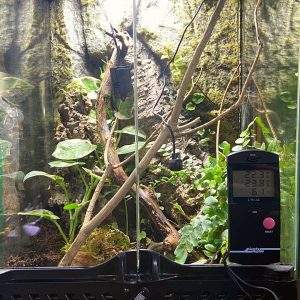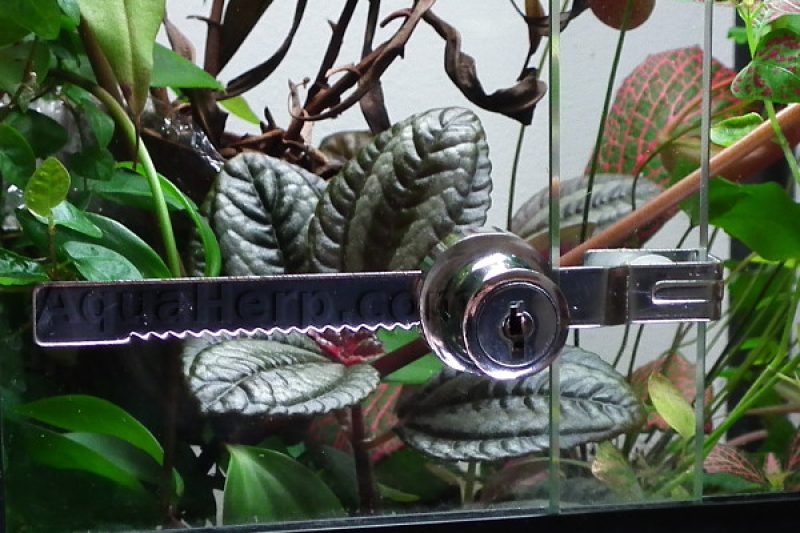
Vivarium Thermometers: How To Choose And Where To Place
If you are keeping anything that doesn’t control its own temperature internally – as birds and mammals do – then you need to control temperature.

Reptiles, amphibians and invertebrates can be challenging to keep well. They all require careful consideration when choosing and maintaining their homes, diet, lighting and heating. Luckily, we’re here to help!
Housing is vitally important to get right. Once you have your chosen vivarium, you need to be able to keep it secure.
Vivarium doors are designed to be easy to open and close. The downside of this is that they are easy to open and close even when you don’t want them to! Children, other pets, even the vivarium occupants – all of them can sometimes open doors when we would rather they remain shut.
So what’s the solution? There are several. They can be broadly split into two main groups; wedges (everything from folded bits of paper to specially designed rubber wedges), and locks. All of them have the same function, which is to make sure that the door only opens when you want it to!
A vivarium lock is a device to make sure that the doors of the vivarium only open when you want them to. They come in several different designs and sizes, so you should be able to find one that fits your pet’s home.
First of all, think about why you need the lock. Are there small children who like to investigate, or do you have a cat that likes to paw at the glass? Perhaps you have a curious gecko or a clever corn snake that can slide the glass doors open!
What you need will depend on what you need it for.
Sliding glass doors. There are two types of lock for these doors. One is for those that have pre-drilled holes in the glass, and the other wraps around the edge of one glass door and the lock rests against the other. If you have a vivarium with pre-drilled glass doors, then it is important to get the right lock in order to prevent your pet trying to get out of the drilled hole and potentially getting stuck.
You can also use rubber wedges between the panes of glass. These use friction to prevent the doors being opened. Probably the cheapest option, but be aware that they can fall out!
Front opening glass doors. Locks to fit these are usually a plastic coated or braided steel wire that can be threaded through a hole in the plastic door catch, secured with a small combination lock.
Usually the brand of front opening glass terrarium will have a corresponding lock available.
Usually, no. Wedges just slide between the closed glass doors, and wrap around glass door locks fit between the panes. It’s possible to thread the lock into a pre-drilled hole, but it is sometimes easier to lift the glass out in order to fit the lock. Other than that, you should be able to fit the lock without removing the glass.
Where you place your lock depends on what sort of vivarium or terrarium you are using, and how secure you need the area to be. Remember that the packaging of the lock will have instructions printed on it, and that we can help you out if you get stuck.
If fitting to a vivarium with pre-drilled doors: make sure that the glass is placed so that the hole for the lock is at the top. This is a very useful way to prevent livefoods from squeezing out through the hole.
If fitting to a vivarium without pre-drilled doors: fit the lock as close to the centre of the glass as possible. You will see that the long bar of the lock has a grub screw to tighten it against the glass; this will have a soft plastic or rubber cap to hold it firmly. Using the lock without this plastic or rubber stopper can crack the glass. Tighten the grub screw so that the long lock bar is held firmly, and check that the glass slides easily with the lock fitted.
Slide the lock body along the bar until it rests against the other pane of glass, and turn the key. If you only have one vivarium you can buy locks with individual keys, so that that key will only open that individual lock. If you have a number of vivariums you can get locks that all share the same key, which means that you don’t have to carry a huge bunch of keys around at feeding time!
Usually, the plastic surrounds to the doors will have a hole in them adjacent to the catch. To secure these doors, slide the lock cable through both holes and slide it into the lock body itself. Once you hear it click, rotate the tumblers to secure the cable in place. To change the combination follow the instructions on the packaging.
In an emergency, a piece of folded paper or card can be used to wedge sliding doors closed. However, this should only ever be a temporary solution! Wedges made of rubber can be bought that actually hold the doors closed very effectively, although if you need to prevent children or other pets from getting into the vivarium then a proper lock is a must.
We hope that you have found this article useful, and that it has helped you to decide on the best way to secure your vivarium to keep your pet safe and happy in their home. Remember that we are always available online or at the end of the phone for help and advice.
If you would like to find out more about our range of locks, lights, vivariums and other reptile keeping equipment, please come in and visit us at our Oxfordshire store. If you can’t come in to visit us, then check out our website or click here to contact our in-house experts. For more information on the best practice for keeping your pet, then check out our care hub to look through our extensive range of caresheets – our blog has lots of interesting information too!

If you are keeping anything that doesn’t control its own temperature internally – as birds and mammals do – then you need to control temperature.
Copyright 2021 Evolution Reptiles
All rights reserved.